References
[1]. S. Javed, B.A. Aldalaien, U. Husain, M.S. Khan, (2019) Impact of Federal Funds Rate on Monthly Stocks Return of United States of America. International Journal of Business and Management; Vol. 14, No.9.
[2]. J. Lee, C. Yue, (2017) Impacts of the US dollar (USD) exchange rate on economic growth and the environment in the United States. Energy Economics, Elsevier, Vol. 64: pp 170-176.
[3]. J.L. Prakken, C.P. Varvares. (2015) The Impact of a Rising Dollar on the U.S. Economy. Business Economics, Vol. 50, No.1,: pp. 25-33.
[4]. C. Ioannidis, A. Kontonikas. (2008) The impact of monetary policy on stock prices. Journal of Policy Modeling, Vol. 20, Issue 1: pp. 33-53.
[5]. Y.D. Li, T.B. İşcan, K. Xu. (2010) The impact of monetary policy shocks on stock prices: Evidence from Canada and the United States. Journal of International Money and Finance, Vol. 29, Issue 5: pp. 876-896.
[6]. G. Jordi, L. Gambetti. (2015) The Effects of Monetary Policy on Stock Market Bubbles: Some Evidence. American Economic Journal: Macroeconomics, Vol. 7: pp. 233-257
[7]. N. Balakrishnan. (2010) Methods and Applications of Statistics in Business, Finance, and Management Science. John Wiley & Sons.
[8]. C.A. Sims. (1980) Macroeconomics and Reality. Econometrica, Vol. 48, No. 1: pp. 1–48.
[9]. N. Naik, B.R. Mohan, R.A. Jha. (2010). GARCH-Model Identification based on Performance of Information Criteria. Procedia Computer Science, Vol 171: pp. 1935–1942.
[10]. R. Shailesh, D. Jeffry, N. Natesan. (2018). Volatility Estimation using GARCH Family of Models: Comparison with Option Pricing. Pacific Business Review International. Vol. 10: pp. 54-60.
Cite this article
Zhao,A.R. (2023). The Effect of Rise of Federal Funds Rate on US Stock Market: From the Perspective of US Dollar Appreciation. Advances in Economics, Management and Political Sciences,43,89-96.
Data availability
The datasets used and/or analyzed during the current study will be available from the authors upon reasonable request.
Disclaimer/Publisher's Note
The statements, opinions and data contained in all publications are solely those of the individual author(s) and contributor(s) and not of EWA Publishing and/or the editor(s). EWA Publishing and/or the editor(s) disclaim responsibility for any injury to people or property resulting from any ideas, methods, instructions or products referred to in the content.
About volume
Volume title: Proceedings of the 7th International Conference on Economic Management and Green Development
© 2024 by the author(s). Licensee EWA Publishing, Oxford, UK. This article is an open access article distributed under the terms and
conditions of the Creative Commons Attribution (CC BY) license. Authors who
publish this series agree to the following terms:
1. Authors retain copyright and grant the series right of first publication with the work simultaneously licensed under a Creative Commons
Attribution License that allows others to share the work with an acknowledgment of the work's authorship and initial publication in this
series.
2. Authors are able to enter into separate, additional contractual arrangements for the non-exclusive distribution of the series's published
version of the work (e.g., post it to an institutional repository or publish it in a book), with an acknowledgment of its initial
publication in this series.
3. Authors are permitted and encouraged to post their work online (e.g., in institutional repositories or on their website) prior to and
during the submission process, as it can lead to productive exchanges, as well as earlier and greater citation of published work (See
Open access policy for details).
References
[1]. S. Javed, B.A. Aldalaien, U. Husain, M.S. Khan, (2019) Impact of Federal Funds Rate on Monthly Stocks Return of United States of America. International Journal of Business and Management; Vol. 14, No.9.
[2]. J. Lee, C. Yue, (2017) Impacts of the US dollar (USD) exchange rate on economic growth and the environment in the United States. Energy Economics, Elsevier, Vol. 64: pp 170-176.
[3]. J.L. Prakken, C.P. Varvares. (2015) The Impact of a Rising Dollar on the U.S. Economy. Business Economics, Vol. 50, No.1,: pp. 25-33.
[4]. C. Ioannidis, A. Kontonikas. (2008) The impact of monetary policy on stock prices. Journal of Policy Modeling, Vol. 20, Issue 1: pp. 33-53.
[5]. Y.D. Li, T.B. İşcan, K. Xu. (2010) The impact of monetary policy shocks on stock prices: Evidence from Canada and the United States. Journal of International Money and Finance, Vol. 29, Issue 5: pp. 876-896.
[6]. G. Jordi, L. Gambetti. (2015) The Effects of Monetary Policy on Stock Market Bubbles: Some Evidence. American Economic Journal: Macroeconomics, Vol. 7: pp. 233-257
[7]. N. Balakrishnan. (2010) Methods and Applications of Statistics in Business, Finance, and Management Science. John Wiley & Sons.
[8]. C.A. Sims. (1980) Macroeconomics and Reality. Econometrica, Vol. 48, No. 1: pp. 1–48.
[9]. N. Naik, B.R. Mohan, R.A. Jha. (2010). GARCH-Model Identification based on Performance of Information Criteria. Procedia Computer Science, Vol 171: pp. 1935–1942.
[10]. R. Shailesh, D. Jeffry, N. Natesan. (2018). Volatility Estimation using GARCH Family of Models: Comparison with Option Pricing. Pacific Business Review International. Vol. 10: pp. 54-60.









